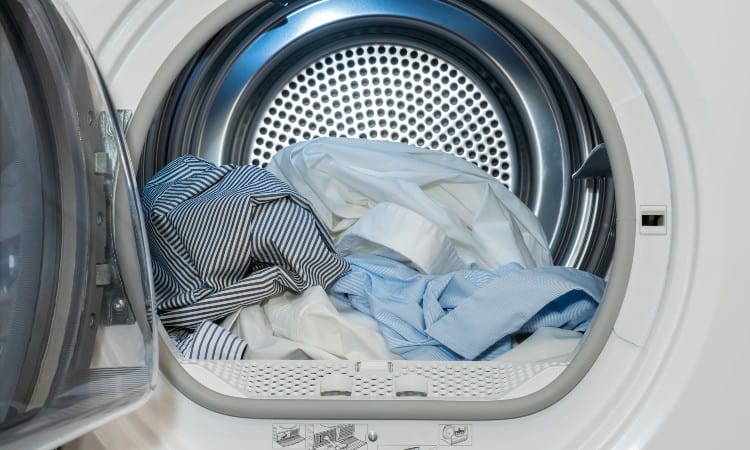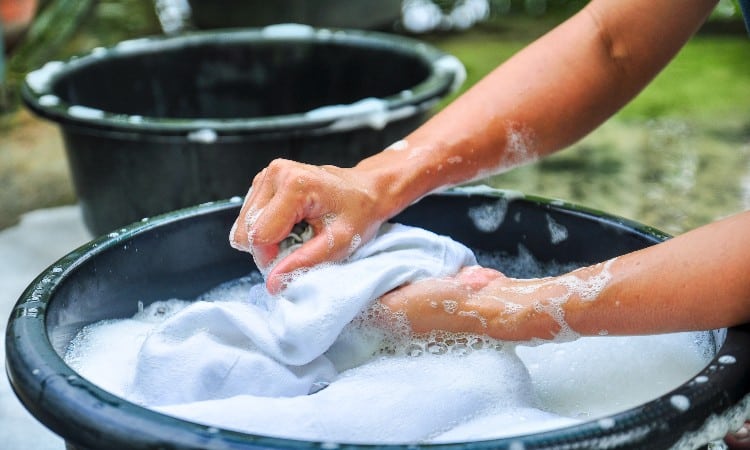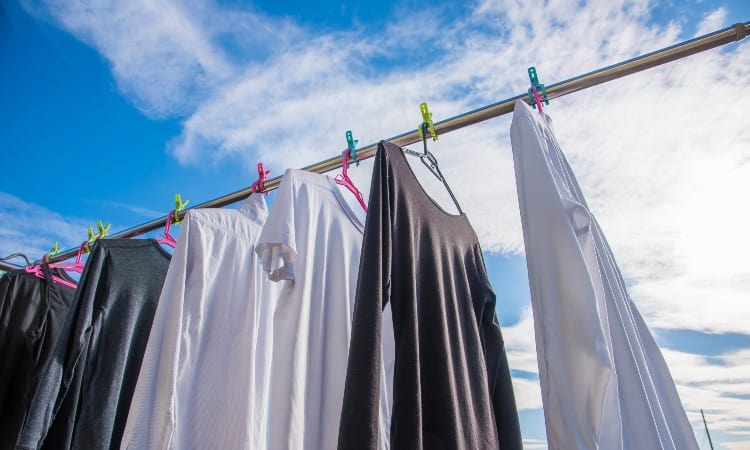Have you ever put on a favorite sweater or t-shirt, only to realize that it shrinks in the wash and the sleeves no longer reach your wrists? Shrinking clothes while doing laundry is a common problem. The good news is that you can learn how to prevent clothes from shrinking in the wash by following a few simple laundry tips!
The best way to prevent clothes from shrinking during laundering is to wash the clothes in cold water on a delicate cycle. If possible, hang the clothes to air dry instead of placing them in the dryer because heat can cause the fabric to shrink. When using a tumble dryer, select a short, gentle cycle such as the air fluff option.
In this article, you will find out what makes clothing shrink. You will discover five simple ways to prevent clothes from shrinking in the laundry. Finally, you will find tips for how to clean clothes made out of cotton, polyester, and more delicate materials.

Quick Navigation
- What Causes Clothes to Shrink?
- Do Clothes Shrink in the Washer or Dryer?
- How to Prevent Clothes From Shrinking: 5 Methods
- Do Clothes Shrink Over Time?
- Does Fabric Softener Shrink Clothes?
- Will Clothes Shrink in a Cold Wash?
- Best Tumble Dryer That Doesn’t Shrink Clothes
- Best Way to Wash Clothes Without Shrinking:
- How to Unshrink Clothes
- Conclusion
What Causes Clothes to Shrink?
Heat and friction can cause clothes to shrink. These two factors can impact almost every type of clothing, but different types of fabric will react with more or less severity.
Your clothes will not all react to the laundering process in the same way. This is because every type of fabric contains unique fibers that will react to heat and agitation in various ways.
First, plant-based fabrics like cotton usually shrink because heat releases the tension that holds the fibers stretched tautly within the threads. Each fiber can relax back into its naturally coiled shape, causing the fabric to “shrink” as the fibers become shorter. Pure cotton clothing can shrink dramatically during laundering, though you will find some exceptions to this rule later in this article!
Second, animal-based fabrics like wool shrink because of agitation. Wool fibers have many tiny scales all over, and when these scales rub together, they will lock onto each other to create a denser, tighter structure in the fabric. Most wool, cashmere, or angora garments will require dry cleaning because they cannot handle the friction of spinning around and around in a washer.
Finally, synthetic fabrics like polyester have a tough nature and do not shrink as easily as all-natural fabrics. But intense heat can still melt, shrink, or scorch a polyester garment!
Do Clothes Shrink in the Washer or Dryer?
Some clothes shrink in the washer and dryer, especially if you use incorrect settings on your appliances. Washer and dryer settings at home or a laundromat can seem quite confusing, but choosing the wrong one can ruin your clothes!
But before you even get to the washing machine, you can save all of your clothes from shrinking in the future just by taking one simple precaution.
Find the manufacturer’s care label inside the garment. This small fabric tag usually hides at the back of a waistband or collar or inside a seam near the hem of the garment. Read the tag carefully.
This tiny clue will tell you if your garment requires dry cleaning if it can go in hot water, and whether or not you can place it in the dryer! This is an amazing shortcut because it takes away all the burden of figuring out how to treat each garment yourself.
Another key thing you can find inside the garment is the type of fabric it contains. You will find the fabric composition printed on the manufacturer’s label. It will say something like “100% cotton” or “50 cotton 50 polyester.” Different kinds of fabric require different laundering, so you want to know this detail upfront!
OK, suppose you read this tag and find out that your shirt contains 100% cotton and can go in a cold water wash and an air fluff or gentle dryer cycle. Now you need to know how to use the settings on your washer and dryer!
Most washers have two separate knobs, dials, or setting devices. One controls water temperature, allowing you to tell the machine to use cool, cold, warm, or hot water. The other determines what kind of agitation the machine will use and the length of the cycles. This offers options like permanent press or delicate.
Dryers often only have one knob or setting device, but this also comes with many choices. These include fluff dry, permanent press, cooling cycles, etc.
You can find out how to safely use these settings to keep your clothes from shrinking in the next section!
How to Prevent Clothes From Shrinking: 5 Methods

The best way to prevent clothes from shrinking is to follow the instructions on the care label inside each garment. These easy wash methods, including using a washing machine, dryer, or handwashing, will help you understand how to follow those directions!
1. In the Washing Machine
The best way to avoid shrinking clothes in the washing machine is to use temperature control to select cold water. Using cold water will remove the heat that can cause plant-based and synthetic fabrics to shrink.
But what if the care label on your clothing says to use a permanent press cycle? What does that even mean?
Check out these tips for how to use your washer to help you avoid shrinking any more clothes in it!
- The normal cotton cycle on a washing machine offers a generic, good-for-most-clothes option. It will run through a full wash and rinse cycle and uses a lot of agitation that can clean bedding, towels, or clothing. If a care tag does not give specific washing machine settings, you should probably use this setting.
- The bulky/heavy/bedsheets option on most washing machines adds a longer wash time and even more agitation. This cycle can clean really big loads of bulky fabric or heavily soiled garments, but you should not select this option for everyday use. You do not often see this setting recommended on a care label.
- Many washing machines also have a Permanent Press option which you should select only if the care label inside the clothing recommends it. This setting can help prevent wrinkles in synthetic fabric because it uses a short 30-minute warm water cycle to relax the fibers inside the fabric. This high-agitation hot water wash cleans and relaxes the clothes and is followed by a cold water rinse to prevent shrinking.
- Finally, another key wash cycle to note is the “Delicates” option. This setting uses very slow and gentle agitation, short wash times, and cold water to handle garments such as lingerie or anything made of silk or satin. If the care label in your clothes says “gentle wash” or “delicate,” you should use this setting!
2. In the Dryer

Like washers, dryers come with various settings that you can use to help avoid shrinking your clothes. In the interest of full disclosure, though, the absolute best way to avoid shrinking clothes in the dryer is to skip the dryer entirely! If you can hang up your clothes to dry outside or on a drying rack, that option will protect your clothes much better than even the most careful use of a dryer.
Your first step in using a dryer to avoid shrinking clothes is to read the care label inside each garment. Some clothes say “air dry” or have a little picture of a dryer with an X over it. In that case, skip this section and scroll down to the section on “air drying” later on in this article!
Other clothes may recommend tumble drying on low heat or in an “air fluff” setting. So, what does that mean?
Not every dryer has every setting option, but most tumble dryers have at least most of these options available:
- Newer or more upscale dryers often have an “air dry” or “fluff” setting that uses no heat! This option simply blows the ambient air over clothes as they tumble dry. This setting works well for clothes you want to avoid shrinking and on already-dry clothes you want to fluff up!
- The delicate option uses lower heat than a regular dryer cycle. If your clothing label says “low heat,” you want to use this setting! It will not dry bulky or thick clothes very quickly, though, so make sure you take the load out of the dryer right away after it finishes to avoid any chance of mildew.
- The “regular” or “timed dry” option on your dryer may come with timing options you can set yourself, such as a 20-minute, 30-minute, or 60-minute heat cycle. The regular setting uses the dryer’s highest heat and intense tumbling action to force clothes to dry quickly.
- Like washers, most dryers come with a permanent press setting designed to prevent wrinkling. This setting uses a low heat through most of the cycle and then switches to cool air at the end to help prevent wrinkles. Many clothes made out of synthetic fabric will recommend this setting on the care label.
As a pro tip, you can also shorten the drying time by tossing several wool dryer balls in with a load of laundry. These balls help fluff up clothing and bedding instead of letting them wad up during the tumble dry, making them dry more quickly!
3. Handwash

Many delicate garments require handwashing to prevent them from ripping or shrinking in the laundry. In this case, the care label will either say “handwash” or have a tiny picture of a bucket of water with a hand inside it.
Handwashing is the absolute most careful, gentle method of caring for clothing. It is also your best option if you have a care tag that says “dry clean only” and you can’t afford to dry-clean them. (Obviously, you should dry clean these items if you can!).
Plus, handwashing uses much less water than a washing machine, saving money on your utility bills! The downside to this method is that it does take much more time.
To handwash delicate clothes:
- Set up a spotlessly clean bucket or basin near a sink. You could also use a sink with a stopper in it, but you will need to thoroughly scrub the sink first if you choose this option! Any grease, makeup, or food particles in the sink will damage your clothing.
- Fill the bucket two-thirds full with cool water.
- Measure in one to two teaspoons of gentle laundry detergent. Swish your hand around to dissolve the soap, but don’t worry if you do not see a lot of suds.
- Next, put one delicate garment at a time into the bucket and let it soak for five minutes. This way, you will not create friction as the clothes rub against each other. Also, you can avoid any dye bleeding from one garment to another.
- Swish the garment around in the cool water for a minute.
- Lift the dripping clothing out and allow some water to drain away. Make sure you do not wring out or crumple up the wet garment, as this could cause it to stretch, wrinkle, or tear!
- Dump out your bucket and refill it with unsoapy water. Swish the garment in this clean water to rinse it out.
- Finally, proceed to the air-dry method to safely dry your delicate clothing without shrinking!
4. Air Dry

One of the best ways to avoid shrinking your clothes is to air-dry them instead of using a dryer. Airy-drying does not expose your clothes to heat, so you avoid one of the biggest causes of shrinking!
You can use the air-dry method after washing clothes in the washing machine or after handwashing them.
- If you hand-washed your clothes, gently roll each garment inside a clean bath towel like icing inside a jelly roll cake. This will press water from the garment without stretching it out or misshaping it.
- If you have an outdoor clothesline, take sturdier garments to dry in the fresh air. This works great for sheets, jeans, t-shirts, or hoodies.
- For more delicate garments, try spreading them on a flat surface such as a sweater drying rack or another clean towel. You will need to turn them over to dry each side if you use this method.
- If you need to hang up your clothes to dry inside, you can use a dryer rack or padded clothes hangers. Make sure you place a basin below to catch any drips!
- As you hang or spread out your clothes to dry, try to leave plenty of room between them so that air can circulate freely. You can even set a fan to blow on the clothes if you have one handy!
- Outside, it usually takes about four hours for clothing to dry in warm weather. Inside, it may take as long as 24 hours for everything to dry fully.
- Make sure you check your clothes all over, focusing on collars, cuffs, hoods, and pockets, to find any remaining damp spots before you put away your clothes.
5. Dry Clean
Dry cleaning your clothes is another great way to avoid shrinking them. The dry cleaning process uses dry chemical solvents instead of water. The process still uses some heat and friction, but these rarely reach high enough levels to cause any shrinking in clothes.
So, does dry cleaning ever shrink clothes? Once in a while, this could happen, but dry cleaning has a much gentler effect on clothing than a washer or dryer. Plus, dry cleaning experts know they have a professional responsibility to return your clothes in perfect condition, so they take extra care with delicate items.
Of course, dry cleaning costs much more than laundering your own clothing. It also uses chemicals that you may not want touching your skin daily. But it is certainly an effective way to avoid shrinking your clothes!
Do Clothes Shrink Over Time?
Many clothes do gradually shrink over time. You may never notice this incremental shrinking if you care for your clothes properly, though! This slow shrinking takes place because of the fabric manufacturing process.
Most fabric contains yarns or threads. Each yarn holds thousands of tiny fibers twisted together into one tight strand. Turning microscopic fibers into yarns puts a lot of strain on the fibers, causing them to stretch out into a straight line.
Over time, the fibers will slowly relax out of that pulled-tight straight line. As the fibers regain a more naturally curled shape, they take up less space and the yarns will slowly grow shorter. This means that the fabric shrinks overall.
You can prevent most of this shrinking by keeping your clothes away from the conditions that cause fibers to relax. This means avoiding heat and friction whenever possible.
Does Fabric Softener Shrink Clothes?
Fabric softener does not shrink clothes, though it can damage them in other ways. Fabric softener can help unshrink clothes if you run into a laundry accident and need to make some quick repairs!
The danger of using fabric softener is that it builds up in clothes over time and will eventually form a barrier over the fibers so soap and water cannot get to the cloth to clean it. This is especially true for synthetic materials.
Will Clothes Shrink in a Cold Wash?
Some clothes shrink even in a cold wash in the washing machine. This happens because friction can cause certain types of fabric to shrink, and even a cold wash still uses a lot of agitation during the wash cycle.
Any type of wool especially will shrink even in cold water because its fibers will interlock and turn into a dense felt when exposed to that much agitation.
You should always read the care label on your clothes before laundering them! Some garments do need handwashing or dry cleaning to prevent shrinking.
Best Tumble Dryer That Doesn’t Shrink Clothes
 The best tumble dryers that don’t shrink clothes come with advanced and expensive features like tanks to evaporate the moisture from the clothing. These dryers have a heat-pump operation system, unlike the more traditional outdoor vent that connects to the outdoors.
The best tumble dryers that don’t shrink clothes come with advanced and expensive features like tanks to evaporate the moisture from the clothing. These dryers have a heat-pump operation system, unlike the more traditional outdoor vent that connects to the outdoors.
If you can afford to buy a top-of-the-line dryer with the best options for preventing clothes shrinkage, look for these features:
- A heat pump dryer that has a special tank to collect moisture.
- Sensors to determine the wet or dry state of clothing and shut off to avoid wasting electricity. This handy feature also prevents clothes from getting too overheated in a long cycle and possibly shrinking!
- A programmable operating system that allows you greater control over what kind of cycle should go with what kind of fabrics. Again, these models usually cost quite a bit more than a standard manual dryer that comes with preset options such as permanent press or regular.
Popular brands for these high-end dryers include Samsung, Bosch, and AEG.
Best Way to Wash Clothes Without Shrinking:
Check out these tips to find out which none-shrinking method you should use for cotton, polyester, and silk clothes!
Cotton Clothes
The best way to wash cotton clothes without shrinking them depends on several factors.
First, recent trends in clothing manufacturing show that many cotton clothes now go through a pre-shrinking treatment before you buy them. This method makes it less likely that t-shirts, jeans, or other cotton clothes will shrink as you launder them. In this case, the care label inside the clothes will indicate that you can place the clothes in the washer and dryer.
Second, you need to consider how dirty your cotton clothes are before selecting a wash option. Underwear and socks may need a hot water wash to get them fully clean.
But most of the time, the safest way to wash cotton clothes without shrinking them is to use a cold water wash and then hang them up to air dry.
Polyester Clothes
Polyester clothes are made out of plastic, making them quite tough and usually easy to clean! Most of the time, you can safely place your synthetic fabrics in the washing machine.
That said, manufacturers typically recommend using permanent press settings on both the washer and the dryer for this kind of fabric. It helps prevent wrinkles and does not get hot enough to melt or shrink the polyester.
Silk or Delicate Clothes
Almost 100% of the time, silk and delicates require handwashing. Some silk items do not even allow dry cleaning! In rare cases, the care tag inside silk garments may allow a washing machine to cycle using the delicate setting on the machine.
Anything made out of wool also usually needs this extra-gentle treatment. Make sure you read the tag inside your favorite sweater, though, because it may contain acrylic instead of wool! You can safely place the synthetic sweaters in your washing machine, but wool needs handwashing.
How to Unshrink Clothes
If you encounter a laundry room disaster and end up with too-small clothes, you can try a few of these tips to unshrink your clothes! Of course, the best method of all is to avoid shrinking in the first place by using the five simple care methods in this article to prevent your clothes from shrinking to begin with.
- One way to unshrink clothes is to use a soak and stretch method. Simply fill a bucket with water and add a couple of tablespoons of either baby shampoo, hair conditioner, or fabric softener. Soak the garment for half an hour. Finally, place the damp clothing on a towel and use your hands to gently stretch it back out!
- If you need your clothes unshrunk in a hurry, try steaming the garment with a handheld clothing steamer. Then use your hands to gently tug on the clothes, pulling on opposite sides of the garment at the same time.
- If you accidentally shrunk jeans or khakis, try dampening them with warm water and then putting them on to stretch them back into shape!
Conclusion
The best way to prevent clothes from shrinking is to read the care label inside the garment and follow its instructions. In general, using cold water in your washing machine can help prevent shrinking. Special dryer settings like permanent press and air fluff can also help prevent shrinking.
The most gentle way to care for your clothes is to hand wash and air-dry the garments individually. This removes the heat and friction used in the washing machine and dryer from the process, which will keep your clothes from shrinking entirely!
Do you have any favorite tricks for caring for your clothes? Do they keep your clothes from shrinking? Leave a comment below to let us know!